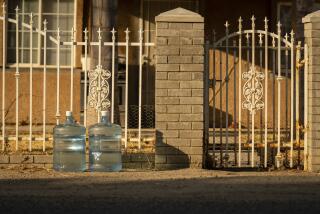Water System Gives Town a Taste of Success
- Share via
WHATELY, Mass. — Residents who had to haul water from a faucet at the elementary school for three years because their shallow wells were contaminated say they have learned the value of pure drinking water.
Nearly a year after 250 families in this farming town of 1,500 people got together on their own time to build a $4-million water system, they still show off to visitors their 500,000-gallon storage tank and basement meters.
And there are few complaints about the cost--$3,500 to $5,000 for a connection plus about $300 a year.
“We get our water bill, we pay it and we are happy,” Irene Hoynoski said.
About three-quarters of the families signed up for the service in the town on the Connecticut River in western Massachusetts about 30 miles north of Springfield.
‘It’s Worth It’
“The cost? It’s worth it just for the peace of mind,” Eileen Haffey said. She was pregnant when the family discovered the house they had just bought had contaminated water.
She said her children got so used to bad water that they automatically asked if they could drink the water when out of town.
Frank Marchand, chairman of the town Water Resource Protection Committee, said cars lined up at the elementary school day and night for water from the outside tap.
“I remember there was one poor woman with a station wagon who came every two days and filled up so many gallon milk jugs that they stretched from the front seat all the way to the back window,” he said. “She must have had to fill up 50 to 60 jugs every two days.”
The two major contaminants in the residents’ wells were ethylene dibromide, used on the tobacco fields, and Temik, used on potatoes, said John Higgins, regional engineer for the state Department of Environmental Quality Engineering.
“But with such shallow wells--most were six to eight feet deep--we could find just about any agricultural chemical we tested for,” Higgins said.
“Whately is a little unique,” he said. “There are small areas in towns all over the state where shallow wells have become contaminated. But it’s not usual to find it affecting half the town.”
The town actually had access to abundant water beneath a 50-foot-thick, protective layer of clay. But residents opted to try a municipal system with one 190-foot-deep well for fear that the deep aquifer would become contaminated as well if everyone drilled through the clay layer, he said.
The town has no full-time employees, so the water system was all volunteer labor.
“The most amazing thing about Whately is how the community came and worked together,” Higgins said. “Everybody had other jobs and yet they got that system built as fast as a city that was paying people full-time to work on the program.”
Money was hard to get. Paul Fleuriel, chairman of the town water commission, boasted: “We bullied the state into helping.”
After three years of negotiations, he managed to wrest from the state nearly $1.5 million in grants. The rest was covered by town borrowing and the connection fees.
Marchand said he would never forget the April, 1987, night that the water district was approved at a town meeting.
“It needed a two-thirds majority vote and it got that by one vote. It was that close,” he said. “There were tears streaming out of people’s eyes.”
More to Read
Sign up for Essential California
The most important California stories and recommendations in your inbox every morning.
You may occasionally receive promotional content from the Los Angeles Times.













